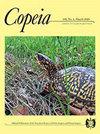三种玻璃蛙产卵地点的选择
IF 2.6
Q2 Agricultural and Biological Sciences
引用次数: 4
摘要
产卵地点的选择是卵生生物繁殖成功的关键。研究了哥斯达黎加东北部三种玻璃蛙(espadarana prosoblepon)、valerioi玻璃蛙(Hyalinobatrachium valerioi)和Teratohyla spinosa)的产卵选择。我们在三种不同栖息地(牧场、次生林和成熟林)的溪流中进行了夜间视觉接触调查,以估计玻璃蛙的卵质量丰度并描述产卵地点特征。我们的研究结果表明,这三种物种的产卵地点选择取决于植被和河流特征。几乎完全在叶片下侧产卵的valerioi和T. spinosa选择光滑的叶片,而在叶片上侧或苔藓中产卵的E. prosoblepon使用的苔藓是可用性的8倍。valerioi在比棘叶棘球蚴和棘球蚴更大的叶片上发现。在缓慢流动的水面上产卵的最多的是棘龙藻和异角龙藻,而在快速流动的水面上产卵的最多的是瓦勒角龙藻。唯一受生境类型影响的种属是褐家兔,其卵块丰度在成熟林中高于次生林和牧场。结果表明,相对于大生境分类,微生境在产卵选择中的作用更大。我们提出适当的河岸微生境是维持玻璃蛙种群在改变生境中的关键因素,并强调在改变景观中保护河岸走廊的重要性。本文章由计算机程序翻译,如有差异,请以英文原文为准。
Oviposition Site Selection in Three Glass Frog Species
Oviposition site selection is critical for the reproductive success of oviparous organisms. We investigated oviposition site selection in three species of glass frogs—Espadarana prosoblepon, Hyalinobatrachium valerioi, and Teratohyla spinosa—in northeastern Costa Rica. We conducted nocturnal visual encounter surveys to estimate glass frog egg mass abundance and characterize oviposition site features in streams of three different habitats (pasture, secondary forest, and mature forest). Our results show differential oviposition site selection among all three species depending on vegetation and stream features. Hyalinobatrachium valerioi and T. spinosa, which oviposit almost exclusively on the underside of leaves, selected smooth leaves, while E. prosoblepon, which oviposits on the upper side of leaves or in moss, used moss eight times more than expected on the basis of availability. Hyalinobatrachium valerioi was found on larger leaves than T. spinosa and E. prosoblepon. Teratohyla spinosa and E. prosoblepon both oviposited most frequently above slow-moving water, while H. valerioi oviposited most frequently above fast-moving water. Espadarana prosoblepon was the only species affected by habitat type and had higher abundances of egg masses in mature forest than in secondary forest and pasture. Our results suggest that microhabitat plays a larger role in oviposition site selection than larger habitat classification. We propose that appropriate riparian microhabitat is a critical factor in sustaining glass frog populations in modified habitats and highlight the importance of preserving riparian corridors in altered landscapes.
求助全文
通过发布文献求助,成功后即可免费获取论文全文。
去求助
来源期刊

Copeia
生物-动物学
CiteScore
2.10
自引率
0.00%
发文量
0
审稿时长
6-12 weeks
期刊介绍:
Founded in 1913, Copeia is a highly respected international journal dedicated to the publication of high quality, original research papers on the behavior, conservation, ecology, genetics, morphology, evolution, physiology, systematics and taxonomy of extant and extinct fishes, amphibians, and reptiles. Copeia is published electronically and is available through BioOne. Articles are published online first, and print issues appear four times per year. In addition to research articles, Copeia publishes invited review papers, book reviews, and compiles virtual issues on topics of interest drawn from papers previously published in the journal.
 求助内容:
求助内容: 应助结果提醒方式:
应助结果提醒方式:


